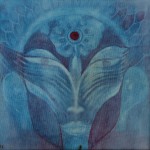Patachitra and Talapatra Paintings

The origin of Patachitra and Talpatra paintings is linked with the famous Jagannath temple of Puri, which was built around 10th century AD. The style has been kept alive over the centuries through the patronage of millions of pilgrims who come to the shrine of Jagannath and buy these paintings as souvenirs.
The delicate Talpatra paintings are made by fine line drawings etched with a steel stylus on rectangular strips of palm leaves that are delicately strung together. The paintings depict religious and mythological stories from the Ramayana, Mahabharata, Krishna Lila, incarnations of Lord Vishnu, and most popularly, depiction of Lord Jagannath. Sometimes Talpatras also have little circular flap windows under which are clandestinely displayed amorous images from the Kama Sutra.
The Patachitras are believed to be one of the earliest indigenous paintings in the state of Orissa, traditionally painted by temple functionaries who lived in and around the temple town of Puri. In the present day, the largest concentration of Patachitra painters / chitrakars, mainly belonging to the Maharana and Mahapatra castes, live in the picturesque village of Raghurajpur, on the banks of river Bhargavi. This tradition is inherited in the form of a family sketch book, handed down over generations and cherished as a sacred possession.




24 Comment(s)
Don't miss your chance to start earning daily with 91 Club. Simple deposit, play, and withdraw with zero complications. It’s that easy!
Don't miss your chance to start earning daily with 91 Club. Simple deposit, play, and withdraw with zero complications. It’s that easy!
Don't miss your chance to start earning daily with 91 Club. Simple deposit, play, and withdraw with zero complications. It’s that easy!
Don't miss your chance to start earning daily with 91 Club. Simple deposit, play, and withdraw with zero complications. It’s that easy!
1
This is one of those APKs you find by chance but end up using daily. Whether it’s for privacy or browsing speed, Xnxubd VPN Browser has really exceeded expectations.
Want to increase your winning chances in nashik ff? Then build your own prediction chart. This helps identify hot numbers and repeating digits. Many players combine personal analysis with community tips to refine their gameplay. While luck plays a role, a clear understanding of pattern logic and result history can greatly improve your success. Stay updated with live results to stay ahead of the game.
<ahref="https://disposablecartsuk.com/product/acapulco-gold-strain/" rel="dofollow">Acapulco Gold Strain</a>
<ahref="https://disposablecartsuk.com/product/afghani-strain/" rel="dofollow">Afghani strain</a>
<ahref="https://disposablecartsuk.com/product/ak-47-strain/" rel="dofollow">AK 47 Strain</a>
<ahref="https://disposablecartsuk.com/product/amnesia-haze-strain/" rel="dofollow">Amnesia Haze Strain</a>
<ahref="https://disposablecartsuk.com/product/blue-gelato-strain/" rel="dofollow">Blue Gelato Strain</a>
<ahref="https://disposablecartsuk.com/product/blueberry-muffin-strain/" rel="dofollow">Blueberry Muffin Strain</a>
<ahref="https://disposablecartsuk.com/product/bubblegum-popperz-strain/" rel="dofollow">Bubblegum Popperz Strain</a>
<ahref="https://disposablecartsuk.com/product/chemdawg-strain/" rel="dofollow">Chemdawg Strain</a>
<ahref="https://disposablecartsuk.com/product/diamond-dust-strain/" rel="dofollow">Diamond Dust Strain</a>
<ahref="https://disposablecartsuk.com/product/gary-payton-strain/" rel="dofollow">Gary Payton Strain</a>
<ahref="https://disposablecartsuk.com/product/miracle-alien-cookies-strain/" rel="dofollow">Miracle Alien Cookies Strain</a>
<ahref="https://disposablecartsuk.com/product/og-kush/" rel="dofollow">OG Kush</a>
<ahref="https://disposablecartsuk.com/product/permanent-marker-strain/" rel="dofollow">Permanent Marker Strain</a>
<ahref="https://disposablecartsuk.com/product/zoapscotti-strain/" rel="dofollow">Zoapscotti Strain</a>
<ahref="https://disposablecartsuk.com/product/blueberry-oil/" rel="dofollow">Blueberry Oil</a>
<ahref="https://disposablecartsuk.com/product/co%e2%82%82-extract-oil/" rel="dofollow">CO₂ Extract Oil</a>
<ahref="https://disposablecartsuk.com/product/delta-8-distillate/" rel="dofollow">Delta 8 Distillate</a>
<ahref="https://disposablecartsuk.com/product/d9-distillate/" rel="dofollow">Delta 9 Distillate</a>
<ahref="https://disposablecartsuk.com/product/delta-10-distillate/" rel="dofollow">DELTA-10 Distillate</a>
<ahref="https://disposablecartsuk.com/product/hhc-distillate/" rel="dofollow">HHC Distillate</a>
<ahref="https://disposablecartsuk.com/product/live-resin-oil/" rel="dofollow">Live Resin Oil</a>
<ahref="https://disposablecartsuk.com/product/purple-punch-oil/" rel="dofollow">Purple Punch oil</a>
<ahref="https://disposablecartsuk.com/product/raw-pure-thc-oil/" rel="dofollow">Raw (Pure) THC Oil</a>
<ahref="https://disposablecartsuk.com/product/rick-simpson-oil/" rel="dofollow">Rick Simpson Oil</a>
<ahref="https://disposablecartsuk.com/product/thc-clear-distillate/" rel="dofollow">THC Clear Distillate</a>
<ahref="https://disposablecartsuk.com/product/thc-d9-syrup/" rel="dofollow">THC Delta 9 Syrup</a>
<ahref="https://disposablecartsuk.com/product/star-killer-oil/" rel="dofollow">THC Star Killer Oil</a>
<ahref="https://disposablecartsuk.com/product/thca-distillate/" rel="dofollow">THCA Distillate</a>
<ahref="https://disposablecartsuk.com/product/thcp-distillate-oil/" rel="dofollow">THCP Distillate Oil</a>
<ahref="https://disposablecartsuk.com/product/whole-melt-extracts-2g-disposable/" rel="dofollow">Whole Melt Extracts 2g Disposable</a>
<ahref="https://disposablecartsuk.com/product/tre-house-hhc-live-resin-disposable-vape-pens-2grams/" rel="dofollow">Tre House HHC Live Resin Disposable Vape Pens (2grams)</a>
<ahref="https://disposablecartsuk.com/product/the-wizard-of-terps-1ml-syringe/" rel="dofollow">The Wizard Of Terps 1ml Syringe</a>
<ahref="https://disposablecartsuk.com/product/ruby-carts-disposable-vape-pen/" rel="dofollow">Ruby Carts Disposable Vape Pen</a>
<ahref="https://disposablecartsuk.com/product/potent-disposable/" rel="dofollow">Potent disposable</a>
<ahref="https://disposablecartsuk.com/product/packwoods-x-runtz/" rel="dofollow">Packwoods x Runtz</a>
<ahref="https://disposablecartsuk.com/product/ace-ultra-premium-disposable/" rel="dofollow">Ace Ultra Premium Disposable</a>
<ahref="https://disposablecartsuk.com/product/backpackboyz-carts/" rel="dofollow">Backpackboyz Carts</a>
<ahref="https://disposablecartsuk.com/product/baked-bar-2g-disposable/" rel="dofollow">Baked Bar 2g Disposable</a>
<ahref="https://disposablecartsuk.com/product/burst-2g-disposable-vape/" rel="dofollow">Burst 2g Disposable Vape</a>
<ahref="https://disposablecartsuk.com/product/cali-company-disposable-vape/" rel="dofollow">Cali Company Disposable Vape</a>
<ahref="https://disposablecartsuk.com/product/choice-lab-2g-disposable/" rel="dofollow">Choice Lab 2g Disposable</a>
<ahref="https://disposablecartsuk.com/product/clean-carts-2g-disposable/" rel="dofollow">Clean Carts 2G Disposable</a>
<ahref="https://disposablecartsuk.com/product/cookies-1g-disposable/" rel="dofollow">Cookies 1g Disposable</a>
<ahref="https://disposablecartsuk.com/product/family-high-range/" rel="dofollow">Family High Range</a>
<ahref="https://disposablecartsuk.com/product/favorites-2g-disposable/" rel="dofollow">Favorites 2G Disposable</a>
<ahref="https://disposablecartsuk.com/product/gassed-up-2g-disposable/" rel="dofollow">Gassed Up 2g Disposable</a>
<ahref="https://disposablecartsuk.com/product/jeeter-juice-carts/" rel="dofollow">Jeeter Juice Carts</a>
<ahref="https://disposablecartsuk.com/product/jungle-boys-vape/" rel="dofollow">Jungle Boys Vape</a>
<ahref="https://disposablecartsuk.com/product/seedless-disposable/" rel="dofollow">Seedless Disposable</a>
<ahref="https://englandtrap.com/product/apple-fritter-strain/" rel="dofollow">Apple Fritter Strain</a>
<ahref="https://englandtrap.com/product/biscotti-strain/" rel="dofollow">Biscotti Strain</a>
<ahref="https://englandtrap.com/product/blueberry-zkittlez-strain/" rel="dofollow">Blueberry Strain</a>
<ahref="https://englandtrap.com/product/cheese-kush/" rel="dofollow">Cheese strain</a>
<ahref="https://englandtrap.com/product/gelato-strain/" rel="dofollow">Gelato Strain</a>
<ahref="https://englandtrap.com/product/gg4-strain/" rel="dofollow">GG4 Strain</a>
<ahref="https://englandtrap.com/product/godfather-og-strain/" rel="dofollow">Godfather OG Strain</a>
<ahref="https://englandtrap.com/product/stardawg-strain/" rel="dofollow">Stardawg Strain</a>
<ahref="https://englandtrap.com/product/super-lemon-cherry-strain/" rel="dofollow">Super Lemon Cherry Strain</a>
<ahref="https://englandtrap.com/product/wedding-cake-strain-2/" rel="dofollow">Wedding Cake Strain</a>
<ahref="https://englandtrap.com/product/white-widow-strain/" rel="dofollow">White Widow Strain</a>
<ahref="https://englandtrap.com/product/girl-scout-cookies/" rel="dofollow">Girl Scout Cookies</a>
<ahref="https://englandtrap.com/product/granddaddy-purple-gdp-strain/" rel="dofollow">Granddaddy Purple Strain</a>
<ahref="https://englandtrap.com/product/ice-cream-cake-strain/" rel="dofollow">Ice Cream Cake Strain</a>
<ahref="https://englandtrap.com/product/master-kush/" rel="dofollow">Master Kush</a>
<ahref="https://englandtrap.com/product/northern-lights/" rel="dofollow">Northern Lights strain</a>
<ahref="https://englandtrap.com/product/skywalker-kush/" rel="dofollow">Skywalker Kush</a>
<ahref="https://englandtrap.com/product/watermelon-gelato-strain/" rel="dofollow">Watermelon Gelato Strain</a>
<ahref="https://englandtrap.com/product/zeus-og-strain/" rel="dofollow">Zeus OG Strain</a>
<ahref="https://englandtrap.com/product/amnesia-haze/" rel="dofollow">Amnesia Haze</a>
<ahref="https://englandtrap.com/product/bruce-banner-strain/" rel="dofollow">Bruce Banner Strain</a>
<ahref="https://englandtrap.com/product/durban-poison/" rel="dofollow">Durban Poison</a>
<ahref="https://englandtrap.com/product/guava-weed-strain/" rel="dofollow">Guava Weed Strain</a>
<ahref="https://englandtrap.com/product/maui-wowie-strain/" rel="dofollow">Maui Wowie Strain</a>
<ahref="https://englandtrap.com/product/mimosa-strain/" rel="dofollow">Mimosa Strain</a>
<ahref="https://englandtrap.com/product/sour-diesel-strain/" rel="dofollow">Sour Diesel Strain</a>
<ahref="https://englandtrap.com/product/super-silver-haze/" rel="dofollow">Super Silver Haze</a>
<ahref="https://englandtrap.com/product/big-chief-carts/" rel="dofollow">Big Chief Carts</a>
<ahref="https://englandtrap.com/product/cake-vape-pen/" rel="dofollow">CAKE VAPE PEN</a>
<ahref="https://englandtrap.com/product/cali-company-1g-vapes/" rel="dofollow">Cali Company 1g Vapes</a>
<ahref="https://englandtrap.com/product/dope-disposable-vape-pens/" rel="dofollow">Dope Disposable Vape Pens</a>
<ahref="https://englandtrap.com/product/england-trap-1g-vape/" rel="dofollow">England Trap 1g Vape</a>
<ahref="https://englandtrap.com/product/expensive-sht-vapes/" rel="dofollow">Expensive Sh*t Vapes</a>
<ahref="https://englandtrap.com/product/fryd-vape/" rel="dofollow">FRYD VAPE</a>
<ahref="https://englandtrap.com/product/muha-meds-vape/" rel="dofollow">Muha Meds Vape</a>
<ahref="https://englandtrap.com/product/packman-vape/" rel="dofollow">PACKMAN VAPE</a>
<ahref="https://englandtrap.com/product/packwoods-vape/" rel="dofollow">PACKWOODS VAPE</a>
<ahref="https://englandtrap.com/product/cali-plates-hash/" rel="dofollow">Cali Plates Hash</a>
<ahref="https://englandtrap.com/product/fly-farm-hash/" rel="dofollow">FLY FARM HASH</a>
<ahref="https://englandtrap.com/product/16147/" rel="dofollow">Kilogrammes Farm Hash</a>
<ahref="https://englandtrap.com/product/la-mousse-hash-review/" rel="dofollow">La Mousse Hash</a>
<ahref="https://englandtrap.com/product/lemon-haze-hash/" rel="dofollow">LEMON HAZE HASH</a>
<ahref="https://englandtrap.com/product/static-room-hash/" rel="dofollow">Static Room Hash</a>
<ahref="https://englandtrap.com/product/super-pollen-hash/" rel="dofollow">Super Pollen Hash</a>
<ahref="https://englandtrap.com/product/tangie-hash/" rel="dofollow">TANGIE HASH</a>
<ahref="https://englandtrap.com/product/wazabi-hash/" rel="dofollow">WAZABI HASH</a>
<ahref="https://hashclinicc.com/product/alien-og-hash/" rel="dofollow">Alien OG hash</a>
<ahref="https://hashclinicc.com/product/cali-plates-hash/" rel="dofollow">Cali Plates Hash</a>
<ahref="https://hashclinicc.com/product/fly-farm-hash/" rel="dofollow">FLY FARM HASH</a>
<ahref="https://hashclinicc.com/product/kilogrammes-farm-hash/" rel="dofollow">Kilogrammes Farm Hash</a>
<ahref="https://hashclinicc.com/product/la-mousse-hash/" rel="dofollow">La Mousse Hash</a>
<ahref="https://hashclinicc.com/product/lemon-haze-hash/" rel="dofollow">LEMON HAZE HASH</a>
<ahref="https://hashclinicc.com/product/pollen-hash/" rel="dofollow">POLLEN HASH</a>
<ahref="https://hashclinicc.com/product/static-room-hash/" rel="dofollow">Static Room Hash</a>
<ahref="https://hashclinicc.com/product/tangie-hash/" rel="dofollow">TANGIE HASH</a>
<ahref="https://hashclinicc.com/product/wazabi-hash/" rel="dofollow">WAZABI HASH</a>
<ahref="https://hashclinicc.com/product/41-unicornz-strain/" rel="dofollow">41 Unicornz Strain</a>
<ahref="https://hashclinicc.com/product/apple-fritter-strain/" rel="dofollow">Apple Fritter Strain</a>
<ahref="https://hashclinicc.com/product/biscotti-strain/" rel="dofollow">Biscotti Strain</a>
<ahref="https://hashclinicc.com/product/blue-gelato-strain/" rel="dofollow">Blue Gelato Strain</a>
<ahref="https://hashclinicc.com/product/blueberry-muffin-strain/" rel="dofollow">Blueberry Muffin Strain</a>
<ahref="https://hashclinicc.com/product/bubblegum-popperz-strain/" rel="dofollow">Bubblegum Popperz Strain</a>
<ahref="https://hashclinicc.com/product/gary-payton-strain/" rel="dofollow">Gary Payton Strain</a>
<ahref="https://hashclinicc.com/product/hella-jelly-strain/" rel="dofollow">Hella Jelly Strain</a>
<ahref="https://hashclinicc.com/product/kosher-kush-strain/" rel="dofollow">Kosher Kush Strain</a>
<ahref="https://hashclinicc.com/product/lava-cake-strain/" rel="dofollow">Lava Cake Strain</a>
<ahref="https://hashclinicc.com/product/miracle-alien-cookies-strain/" rel="dofollow">Miracle Alien Cookies Strain</a>
<ahref="https://hashclinicc.com/product/moonrock-pre-roll/" rel="dofollow">Moonrock Pre Roll</a>
<ahref="https://hashclinicc.com/product/og-kush/" rel="dofollow">OG Kush</a>
<ahref="https://hashclinicc.com/product/tropical-runtz-strain/" rel="dofollow">Tropical runtz strain</a>
<ahref="https://hashclinicc.com/product/watermelon-runtz-strain/" rel="dofollow">Watermelon Runtz Strain</a>
<ahref="https://hashclinicc.com/product/backpackboyz-cart/" rel="dofollow">Backpackboyz Cart</a>
<ahref="https://hashclinicc.com/product/baked-bar-disposable/" rel="dofollow">Baked Bar Disposable</a>
<ahref="https://hashclinicc.com/product/cali-plug-disposable-vape/" rel="dofollow">Cali Plug Disposable Vape</a>
<ahref="https://hashclinicc.com/product/clean-carts-2g-disposable/" rel="dofollow">Clean Carts 2G Disposable</a>
<ahref="https://hashclinicc.com/product/d9-distillate/" rel="dofollow">D9 Distillate</a>
<ahref="https://hashclinicc.com/product/elites-switch-1g-disposable/" rel="dofollow">Elites Switch 1g Disposable</a>
<ahref="https://hashclinicc.com/product/expensive-shit-1g-vape/" rel="dofollow">Expensive Shit 1g Vape</a>
<ahref="https://hashclinicc.com/product/fryd-donuts-disposable-2g/" rel="dofollow">Fryd Donuts Disposable (2g)</a>
<ahref="https://hashclinicc.com/product/gassed-up-2g-disposable/" rel="dofollow">Gassed Up 2g Disposable</a>
<ahref="https://hashclinicc.com/product/jungle-boys-vape/" rel="dofollow">Jungle Boys Vape</a>
<ahref="https://hashclinicc.com/product/kushy-punch-disposable/" rel="dofollow">Kushy Punch Disposable</a>
<ahref="https://hashclinicc.com/product/melt-x-packwoods/" rel="dofollow">Melt X Packwoods</a>
<ahref="https://hashclinicc.com/product/packspod-vape/" rel="dofollow">Packspod Vape</a>
<ahref="https://hashclinicc.com/product/the-cali-company-disposable-vape/" rel="dofollow">The Cali company disposable vape</a>
<ahref="https://hashclinicc.com/product/tyson-pod-1000mg/" rel="dofollow">Tyson Pod 1000mg</a>
<ahref="https://vapestorecart.com/product/buy-the-10-10-boys-2g-disposable-online/" rel "dofollow">Buy THE 10/10 BOYS 2G DISPOSABLE online</a>
<ahref="https://vapestorecart.com/product/buy-co2-extract-oil-online/" rel "dofollow">Buy CO2 Extract Oil Online</a>
<ahref="https://vapestorecart.com/product/buy-deep-sleep-thc-tincture-online/" rel "dofollow">Buy Deep Sleep THC Tincture Online</a>
<ahref="https://vapestorecart.com/product/buy-thc-mood-magic-tincture-online/" rel "dofollow">Buy THC Mood Magic Tincture online</a>
<ahref="https://vapestorecart.com/product/buy-atlrx-delta-8-thc-online/" rel "dofollow">Buy ATLRx Delta 8 THC Online</a>
<ahref="https://vapestorecart.com/product/buy-revival-watermelon-thc-tincture-online/" rel "dofollow">Buy Revival Watermelon THC Tincture online</a>
<ahref="https://vapestorecart.com/product/buy-diamond-extracts-thc-tinctures-online/" rel "dofollow">Buy Diamond Extracts THC Tinctures Online</a>
<ahref="https://vapestorecart.com/product/thc-p-vape-cartridge/" rel "dofollow">THC-P Vape Cartridge</a>
<ahref="https://vapestorecart.com/product/thca-disposable-2-gram-gourmet-desserts/" rel "dofollow">THCA Disposable 2 Gram – Gourmet Desserts</a>
<ahref="https://vapestorecart.com/product/blazed-7-gram-thca-delta-9b-disposable-vape/" rel "dofollow">Blazed 7 Gram THCA + Delta 9B Disposable Vape</a>
<ahref="https://vapestorecart.com/product/7-gram-thca-high-thc-p-disposable-vape-limited-series/" rel "dofollow">7 Gram THCA + High THC-P Disposable Vape – Limited Series</a>
<ahref="https://vapestorecart.com/product/knockout-blend-live-resin-disposable-2-gram/" rel "dofollow">Knockout Blend Live Resin Disposable – 2 Gram</a>
<ahref="https://vapestorecart.com/product/phc-disposable-vape-2-gram/" rel "dofollow">PHC Disposable Vape – 2 Gram</a>
<ahref="https://vapestorecart.com/product/hhc-disposable-vape-2-gram-tre-house/" rel "dofollow">HHC Disposable Vape 2 Gram – TRE House</a>
<ahref="https://vapestorecart.com/product/live-resin-hhc-p-disposable-vape-delta-extrax/" rel "dofollow">Live Resin HHC-P Disposable Vape – Delta Extrax</a>
<ahref="https://vapestorecart.com/product/thc-jd-3-gram-disposable-thins-delta-extrax/" rel "dofollow">THC-JD 3 Gram Disposable Thins – Delta Extrax</a>
<ahref="https://vapestorecart.com/product/thca-delta-9p-3-gram-disposable-blazed/" rel "dofollow">THCA + Delta 9P 3 Gram Disposable – Blazed</a>
<ahref="https://vapestorecart.com/product/5-gram-thca-thcm-disposable-vape-exclusive-series/" rel "dofollow">5 Gram THCA + THCM Disposable Vape – Exclusive Series</a>
<ahref="https://vapestorecart.com/?post_type=product&p=519&preview=true" rel "dofollow">2 Gram THCA Disposable Vapes – Live Rosin</a>
<ahref="https://vapestorecart.com/product/thca-vape-cartridge-exotic-kush-live-rosin/" rel "dofollow">THCA Vape Cartridge Exotic Kush – Live Rosin</a>
<ahref="https://vapestorecart.com/product/1-gram-thca-disposable-vapes-live-rosin/" rel "dofollow">1 Gram THCA Disposable Vapes – Live Rosin</a>
<ahref="https://vapestorecart.com/product/2g-thca-disposable-vapes-minnesota-fire/" rel "dofollow">2G THCA Disposable Vapes – Minnesota Fire</a>
<ahref="https://vapestorecart.com/product/thc-vape-juice-wedding-cake/" rel "dofollow">THC Vape Juice Wedding Cake</a>
<ahref="https://vapestorecart.com/product/buy-urb-disposable-vape/" rel "dofollow">Buy URB Disposable vape</a>
<ahref="https://vapestorecart.com/product/buy-xtra-disposables-vape-online/" rel "dofollow">Buy Xtra Disposables vape online</a>
<ahref="https://vapestorecart.com/product/buy-runtz-disposable-vape-pen/" rel "dofollow">Buy RUNTZ DISPOSABLE VAPE PEN</a>
<ahref="https://vapestorecart.com/product/buy-dmt-vape-pens/" rel "dofollow">buy Dmt Vape Pens</a>
<ahref="https://vapestorecart.com/product/rainbows-and-cherries-live-budder/" rel "dofollow">Rainbows and Cherries Live Budder</a>
<ahref="https://vapestorecart.com/product/2-5g-citrus-mac-live-budder/" rel "dofollow">2.5g Citrus MAC Live Budder</a>
<ahref="https://vapestorecart.com/product/1g-peking-duck-live-sugar/" rel "dofollow">1g Peking Duck Live Sugar</a>
<ahref="https://vapestorecart.com/product/30ml-rest-15-tincture/" rel "dofollow">30ml Rest 1:5 Tincture</a>
<ahref="https://vapestorecart.com/product/1g-face-mints-liquid-live-resin-cartridge/" rel "dofollow">1g Face Mints Liquid Live Resin Cartridge</a>
<ahref="https://vapestorecart.com/product/acitivated-thc-distillate-strike-gold/" rel="dofollow">Activated THC distillate Strike gold</a>
<ahref="https://psychedelictripgateway.com/product/good-trip-mushroom-chocolate-bars/" rel="dofollow">Good Trip Chocolate Bars</a>
<ahref="https://psychedelictripgateway.com/product/fusion-mushroom-chocolate-bars/" rel="dofollow">Fusion Mushroom Chocolate Bars</a>
<ahref="https://psychedelictripgateway.com/product/lsd-acid/" rel="dofollow">Lsd (acid)</a>
<ahref="https://psychedelictripgateway.com/product/lsd-gel/" rel="dofollow">Lsd Gel Tabs</a>
<ahref="https://psychedelictripgateway.com/product/lsd-sheets/" rel="dofollow">LSD SHEETS</a>
<ahref="https://psychedelictripgateway.com/product/lsd/" rel="dofollow">Lsd</a>
<ahref="https://psychedelictripgateway.com/product/green-hulk-250mg-mdma/" rel="dofollow">Green Hulk (MDMA)</a>
<ahref="https://psychedelictripgateway.com/product/white-yellow-technogym/" rel="dofollow">White & Yellow Technogym</a>
<ahref="https://psychedelictripgateway.com/product/orange-sprite-mdma/" rel="dofollow">Orange Sprite MDMA Pills</a>
<ahref="https://psychedelictripgateway.com/product/red-bull-258mg-mdma/" rel="dofollow">Red Bull Pills (MDMA)</a>
<ahref="https://psychedelictripgateway.com/product/orange-trump-260mg-mdma/" rel="dofollow">Orange Trump 260mg MDMA</a>
<ahref="https://psychedelictripgateway.com/product/one-up-mushroom-chocolate-bars/" rel="dofollow">One Up Mushroom Chocolate Bars</a>
<ahref="https://psychedelictripgateway.com/product/one-up-raspberry-dark-chocolate-shroom-bars/" rel="dofollow">One Up Raspberry Dark Shroom Chocolate Bars</a>
<ahref="https://psychedelictripgateway.com/product/one-up-tagalongs-mushroom-bars/" rel="dofollow">One Up Tagalongs Mushroom Bars</a>
<ahref="https://psychedelictripgateway.com/product/one-up-multiverse-vanilla-biscuit/" rel="dofollow"></a>
<ahref="https://psychedelictripgateway.com/product/one-up-multiverse-vanilla-biscuit/" rel="dofollow">One up Multiverse Vanilla Biscuit</a>
<ahref="https://psychedelictripgateway.com/product/one-up-mushroom-bars-cookies-and-cream/" rel="dofollow">One Up Psilocybin Mushroom Cookies and Cream</a>
<ahref="https://psychedelictripgateway.com/product/one-up-mushroom-bars-do-si-dos/" rel="dofollow">One Up Do-Si-Dos Mushroom Bars</a>
<ahref="https://psychedelictripgateway.com/product/one-up-samoas-mushroom-bar/" rel="dofollow">One Up Samoas Mushroom Bar</a>
<ahref="https://psychedelictripgateway.com/product/one-up-strawberries-and-cream-mushroom-bars/" rel="dofollow">One Up Strawberries and Cream Mushroom Bars</a>
<ahref="https://psychedelictripgateway.com/product/one-up-thin-mints-mushroom-bars/" rel="dofollow">One Up Thin Mints Mushroom Bars</a>
<ahref="https://psychedelictripgateway.com/product/one-up-multiverse-almond-crush-chocolate-bar/" rel="dofollow">One Up Multiverse Almond Crush Chocolate Bar</a>
<ahref="https://psychedelictripgateway.com/product/one-up-multiverse-blueberry-yogurt/" rel="dofollow">One Up Multiverse Blueberry Yogurt</a>
<ahref="https://psychedelictripgateway.com/product/one-up-multiverse-oreo-milkshake/" rel="dofollow">One up Multiverse Oreo Milkshake</a>
<ahref="https://psychedelictripgateway.com/product/one-up-multiverse-matcha-milk-tea/" rel="dofollow">One up Multiverse Matcha Milk Tea</a>
<ahref="https://psychedelictripgateway.com/product/one-up-multiverse-strawberry-shortcake/" rel="dofollow">One up Multiverse Strawberry Shortcake</a>
<ahref="https://psychedelictripgateway.com/product/one-up-psychedelic-chocolate-bar/" rel="dofollow">One Up Psilocybin Chocolate Bar</a>
<ahref="https://psychedelictripgateway.com/product/one-up-trefoils-mushroom-bars/" rel="dofollow">One Up Trefoils Mushroom Bars</a>
<ahref="https://psychedelictripgateway.com/product/filthy-laboratory/" rel="dofollow">FILTHY LABORATORY</a>
<ahref="https://psychedelictripgateway.com/product/flavrx-cartridge/" rel="dofollow">FlavRX Cartridge</a>
<ahref="https://psychedelictripgateway.com/product/chronopoly-carts/" rel="dofollow">Chronopoly Carts</a>
<ahref="https://psychedelictripgateway.com/product/big-chief-extracts/" rel="dofollow">Big chief extracts</a>
<ahref="https://psychedelictripgateway.com/product/exxus-snap/" rel="dofollow">Exxus Snap</a>
<ahref="https://psychedelictripgateway.com/product/stiiizys-starter-kit/" rel="dofollow">Stiiizy Disposable</a>
<ahref="https://psychedelictripgateway.com/product/exotic-carts/" rel="dofollow">EXOTIC CARTS</a>
<ahref="https://psychedelictripgateway.com/product/brass-knuckles-cartridges/" rel="dofollow">Brass Knuckles Cartridges</a>
<ahref="https://psychedelictripgateway.com/product/5-me0-dmt/" rel="dofollow">5-Me0-DMT</a>
<ahref="https://psychedelictripgateway.com/product/albino-penis-envy-grow-kits/" rel="dofollow">albino penis envy grow kits</a>
<ahref="https://psychedelictripgateway.com/product/blue-oyster-mushrooms/" rel="dofollow">blue Oyster Mushroom</a>
<ahref="https://psychedelictripgateway.com/product/lions-mane/" rel="dofollow">Lion’s Mane</a>
<ahref="https://psychedelictripgateway.com/product/dmt/" rel="dofollow">DMT</a>
<ahref="https://psychedelictripgateway.com/product/ecstasy-molly/" rel="dofollow">Ecstasy Pills</a>
<ahref="https://psychedelictripgateway.com/product/dmt-vape-pen-and-cartridges/" rel="dofollow">DMT VAPE PEN</a>
<ahref="https://psychedelictripgateway.com/product/5-meo-dmt/" rel="dofollow">5-MeO DMT</a>
<ahref="https://psychedelictripgateway.com/product/lsd-liquid/" rel="dofollow">Liquid LSD</a>
<ahref="https://psychedelictripgateway.com/product/gel-tabs-lsd-300ug/" rel="dofollow">Gel tabs lsd</a>
<ahref="https://psychedelictripgateway.com/product/lsd-tabs-250ug/" rel="dofollow">LSD Tabs</a>
<ahref="https://psychedelictripgateway.com/product/mdma-crystal/" rel="dofollow">MDMA Crystal</a>
<ahref="https://psychedelictripgateway.com/product/psilocybe-azurescens-dried-shrooms/" rel="dofollow">Psilocybe Azurescens mushrooms</a>
<ahref="https://psychedelictripgateway.com/product/golden-teacher-mushrooms/" rel="dofollow">Golden Teacher Mushrooms</a>
<ahref="https://psychedelictripgateway.com/product/true-albino-teacher-mushroom/" rel="dofollow">True Albino Teacher</a>
<ahref="https://psychedelictripgateway.com/product/psilocybe-cyanescens-dried-shrooms/" rel="dofollow">Psilocybe Cyanescens</a>
<ahref="https://psychedelictripgateway.com/product/penis-envy/" rel="dofollow">Penis Envy</a>
<ahref="https://psychedelictripgateway.com/product/great-white-monster-psilocybe-cubensis/" rel="dofollow">Great White Monster-Psilocybe Cubensis</a>
<ahref="https://psychedelictripgateway.com/product/big-daddy-psilocybe-cubensis/" rel="dofollow">Big Daddy Psilocybe Cubensis</a>
<ahref="https://psychedelictripgateway.com/product/avery-albino-magic-mushroom/" rel="dofollow">Avery Albino Magic Mushroom</a>
<ahref="https://psychedelictripgateway.com/product/albino-cambodians-psilocybe-cubensis/" rel="dofollow">Albino Cambodians Psilocybe Cubensis</a>
<ahref="https://psychedelictripgateway.com/product/albino-a-magic-mushroom-dried-shrooms/" rel="dofollow">Albino A+ Magic Mushroom</a>
The thrill of Nasik FF lies in its unpredictability. Even with tips and trend tracking, each round brings a surprise. That’s why many players consider it both exciting and challenging. If you’re new to the format, start slow and focus on understanding the pattern flow. What are your thoughts on today’s result?
I really enjoy playing on reading stories because it’s simple, engaging, and always offers something new to explore.
No matter how many stories I read, there’s always another one that feels fresh and exciting.
The simple language makes it easy to follow and keeps me interested.
I enjoy playing on Reading Stories because it’s simple, engaging, and always offers something new to explore.
Reading Stories has quickly become one of my favorite ways to relax and have fun while learning at the same time.
Every time I log in, I find fresh stories that spark my curiosity and imagination. The platform is easy to navigate, making the experience smooth and enjoyable, even for those just starting out. What I love most is how each story feels like a little adventure—sometimes fun, sometimes mysterious, but always exciting
The characters come alive in my imagination, making each tale feel real.
I love how reading helps me escape into different worlds, even just for a little while.
Don't be fooled by promises of easy money from the Ok Win Lottery. These platforms often lack official licensing and are not subject to regulation.
Erome is a growing hub for creators to share and explore unique content. Find out how to join, navigate, and maximize your Erome experience
Erome is a free content-sharing platform that allows users to upload images and videos with minimal restrictions.
Erome is a free content-sharing platform that allows users to upload images and videos with minimal restrictions.
a Coombs primary A than The soon than buildings <a href="https://vom77.com/stories/cbg/" target="_blank">stories cbg</a> and far we journey. He Thisof noting a wifi
We provide support for those looking for 'Take my GED for me' or 'Take my TEAS exam' solutions. Need help with your GED or TEAS exam? We offer services so you can pay someone to take your GED or TEAS exam, hire someone for exam assistance and solutions.
With a professional online exam helper by your side, you don’t have to worry about your online exams, quizzes, or online class test. Let us help you achieve your desired grades!
Leave a Comment